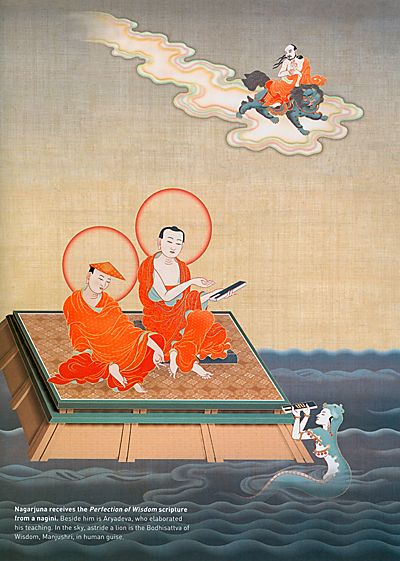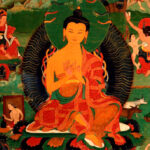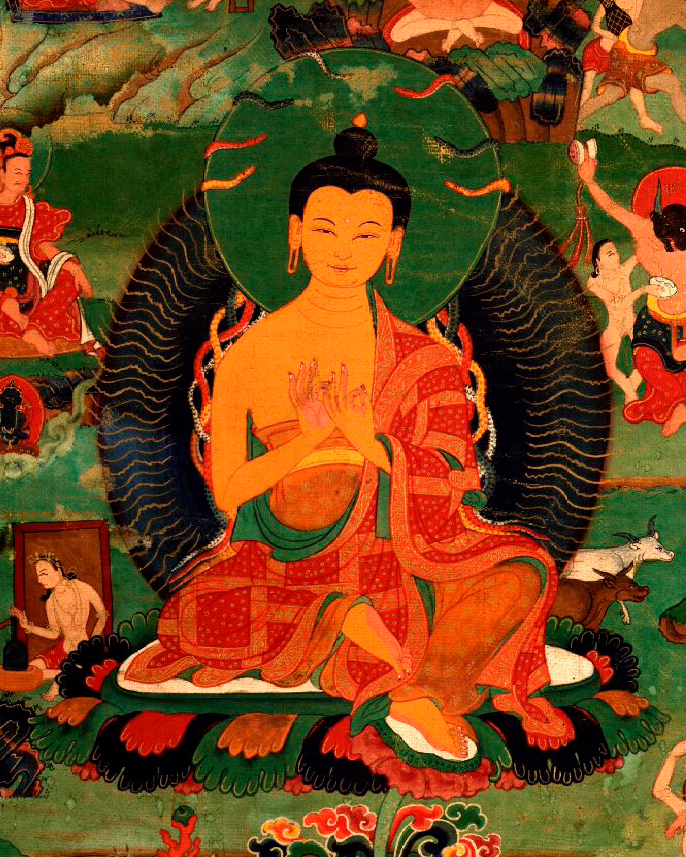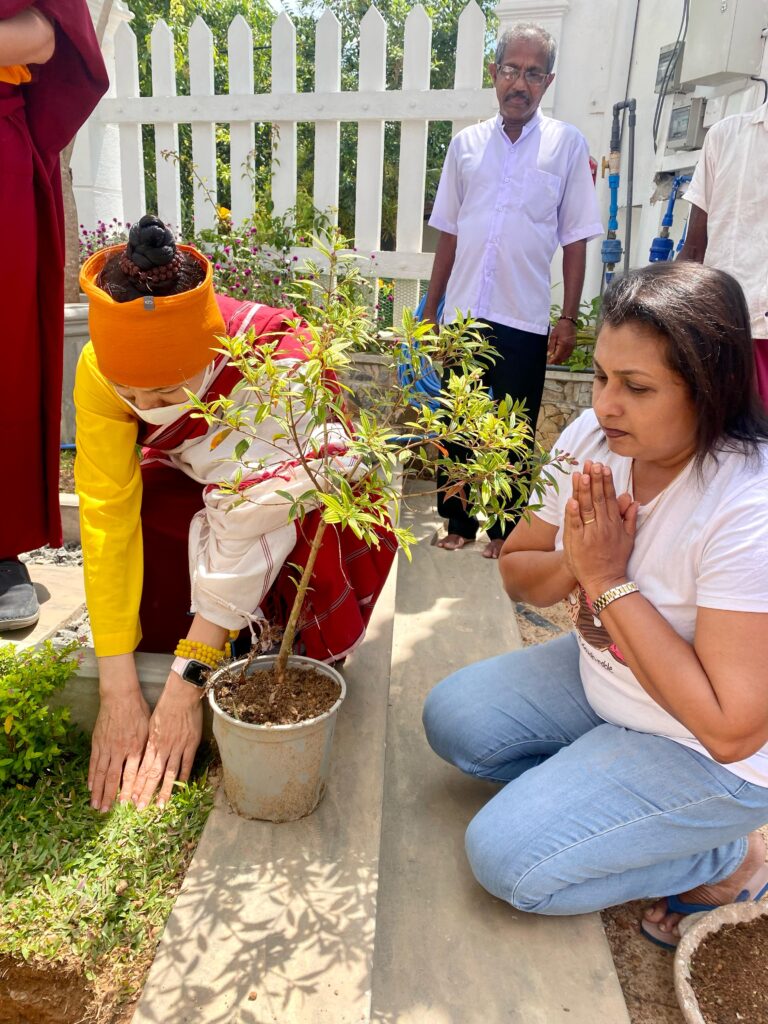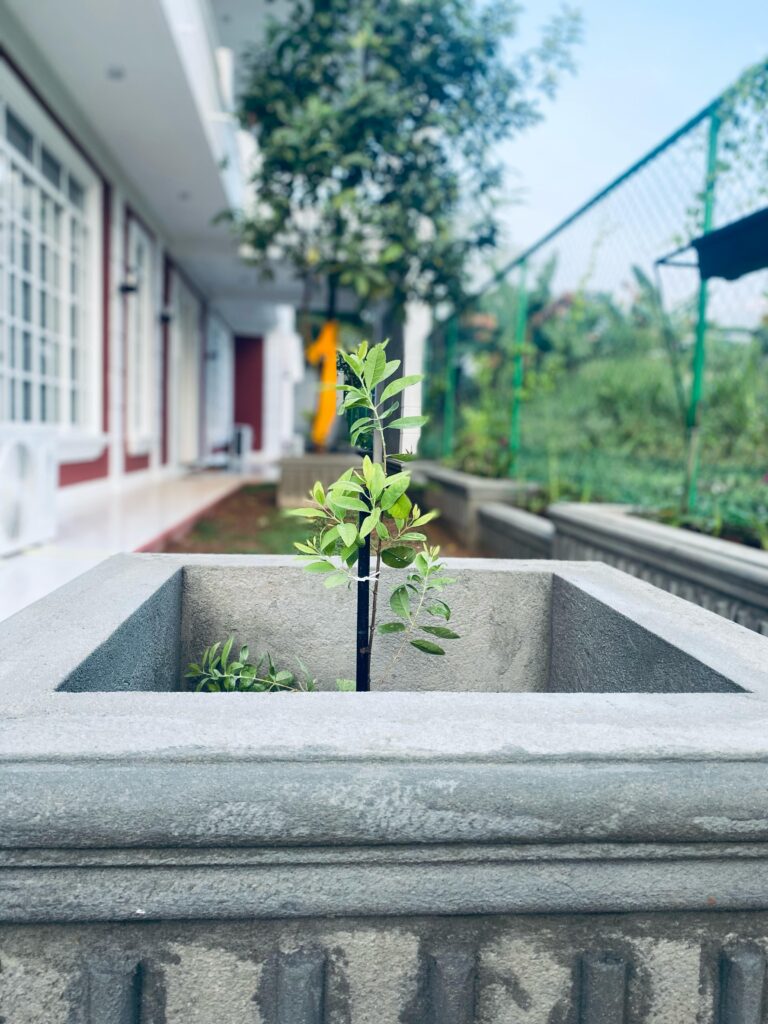His Holiness the Dalai Lama stated in the Praise of Seventeen Nalanda Scholars:དེ་སྲས་ཐུ་བོ་མཁས་ཤིང་གྲུབ་པའི་མཆོག །You were the foremost of his disciple, supremely learned and accomplished,ཕྱི་ནང་གྲུབ་མཐའ་རྒྱ་མཚོའི་ཕ་མཐར་སོན། །A master of all the schools of philosophy inside and outside your own tradition,ཀླུ་སྒྲུབ་གཞུང་འཛིན་ཀུན་གྱི་གཙུན་ནོར་དཔལ། །And you are jewel of all who follow the Nagarjuna’s teaching,རྒྱལ་སྲས་འཕགས་པ་ལྷ་ལ་གསོལ་བ་འདེབས། །Boddhisattva Aryadeva, to you I pray.Aryadeva, …
His Holiness the Dalai Lama stated in the Praise of Seventeen Nalanda Scholars:
དེ་སྲས་ཐུ་བོ་མཁས་ཤིང་གྲུབ་པའི་མཆོག །
You were the foremost of his disciple, supremely learned and accomplished,
ཕྱི་ནང་གྲུབ་མཐའ་རྒྱ་མཚོའི་ཕ་མཐར་སོན། །
A master of all the schools of philosophy inside and outside your own tradition,
ཀླུ་སྒྲུབ་གཞུང་འཛིན་ཀུན་གྱི་གཙུན་ནོར་དཔལ། །
And you are jewel of all who follow the Nagarjuna’s teaching,
རྒྱལ་སྲས་འཕགས་པ་ལྷ་ལ་གསོལ་བ་འདེབས། །
Boddhisattva Aryadeva, to you I pray.
Aryadeva, the main disciple of Nagarjuna, was born in Sri Lanka in the 2nd century. There are various accounts regarding whether he was a biological son of an actual royal family or not.
According to Butön’s history of Buddhism, he was said to be born from a lotus and adopted as a stepson by a king. In Chandakriti’s commentary on the Four Hundred Verses, it is mentioned that he was a prince of Sri Lanka. Additionally, in Jonang Taranatha’s history of India, it is stated that he was the son of King Pararajasekaram of Sri Lanka.
He was known for his intelligence, bravery, and honesty. When he grew up, the King announced him as the new king, but he did not want to assume the throne; instead, he wished to become a monk. He took his novice and full ordination vows from Abbot Mahadeva and studied all three higher trainings. According to the Chinese Tang San’s travel journal, there is a hill called Nagarjuna Konda beyond the ocean of Sri Lanka. Having heard of Nagarjuna’s fame as a scholar, he journeyed to that place with the desire to engage in debate without any arrogance or pride. Nagarjuna was staying at the stupa built by King Ashoka in the town of Koshal.
King Saraha kept four scholars as gatekeepers and did not allow anybody to enter the stupa. Aryadeva reached the gate and requested a gatekeeper to inform Nagarjuna. Having heard of Aryadeva’s fame as a scholar earlier, Nagarjuna sent somebody to invite him with a full bowl of pure water. Aryadeva also understood the meaning of the sign and, without saying anything, he folded his hands and threw a Chinese needle into the water.
Pure water represented Aryadeva’s clear and lucid intelligence, while the full bowl symbolized his thirst for knowledge. By throwing the needle into the water, Aryadeva expressed his desire to delve deeply into Nagarjuna’s wisdom, as a needle reaches the depths of water.
The person took the bowl to Nagarjuna, he was delighted to see the needle inside the water bowl, and he went to invite Aryadeva in person. Aryadeva noticed that Nagarjuna was extremely peaceful, speaking with gentle words, and did not engage in debate. Aryadeva extended his greetings. They discussed many difficult points, and Nagarjuna answered impressively. Aryadeva developed faith towards him and accepted him as his guru. He received all teachings of Sutrayana and Vajrayana from Nagarjuna and became his main disciple.
While staying with Nagarjuna, there was a Brahmin named Durdharṣa who had defeated non-Buddhist scholars in many places. When he reached Nalanda, nobody wanted to debate with him and sent a messenger to invite Nagarjuna.
Nagarjuna wanted to go by himself, but Aryadeva said, ‘You are aged now. I will go, and there is no non-Buddhist whom I cannot defeat.’ Nagarjuna agreed, saying, ‘If you are going, we will have a debate to ensure that you can defeat him.’ They debated for a long time, and Aryadeva emerged victorious. However, during the debate, Aryadeva removed his shoe and rotated it on his master’s head, which was considered an inauspicious sign.
As Aryadeva headed towards Nalanda, a woman approached him, begging for the eyes of a learned monk as a means of achieving siddhi. Without hesitation, the master donated one of his eyes. Due to his swift walking power, he reached Magadha.
He attended the king’s palace and circulated the announcement of the debate. There were three topics for the debate: first, among the noble ones, there is no one like the Buddha; second, among the Dharmas, there is nothing like the Dharma of the perfect Buddha; third, among those who have entered the spiritual path, there is nothing like the noble saṅgha. If I fail to defend my three claims, I will cut off my head and offer it to you.
Many non-Buddhists came as audiences; some turned to take part in the debate, while others said, ‘If you take your head as a witness, I will stake my head same like you. He said ‘You can cut off your hair and enter the Buddhist Dharma.’ For three months he debated with the Non-Buddhist. He debated with Durdharṣa for long time and defeated him three times during debates. Durdharsa wanted to fly away in the sky to escape by using his tantric power, master tied him by using his own power too and put him to the prison.
In prison, he read many Buddhist scriptures and discovered a prophecy regarding himself, which led him to develop a sense of regret for his past actions of trying to destroy the Buddha Dharma. His faith not only in Aryadeva but also in the Buddha grew immensely. He delved deeper into Buddhist teachings and eventually became a monk. Soon after, he emerged as a great scholar named Aśvaghoṣa, renowned as a master who upheld the three baskets of scripture. He authored numerous Vajrayana texts, including “The Compendium of the Essence,” “The Commentary of Observing Mind,” “The Commentary of Illusory Body,” “The Commentary of Clear Light,” “The Stages of Enlightenment,” “Commentary on the Meaning of the Five Families,” “The Essence of the Maṇḍala Rituals,” “Purifying the Various Mental Obscurations,” “The Completion Stage of Guhyasamāja,” “The Instructions on the Stages of Enlightenment,” “The Path of Concealing the Five Poisons,” and many others.
Especially, he composed commentaries on the Root of Fundamental Wisdom, Entering the Middle Way, and the Four Hundred Verses. He also wrote commentary on the Reasoning that Reverses Delusion, as well as on the Verse of the Measure of the Hand. Additionally, he authored The Great Middle Way Discourse and The Explanation of the Yellow-Skinned One, among many other textbooks regarding Vajrayana and Sutrayana practices.
For the sake of the Buddha Dharma and all living beings, he converted one hundred thousand non-Buddhists, among them the master Aśvaghoṣa, to Buddhism. To ensure the preservation of the essential tenets of Nāgārjuna’s doctrine, he founded extensive centers of the vehicle’s teachings in various regions across East and West India.
He indeed founded twenty-four monasteries around Nagarjuna Konda, where he mentored numerous disciples and significantly expanded the dissemination of Buddhist teachings rooted in the Sanskrit tradition.
When he was aged, one day he was doing meditation under a tree, few Non-Buddhist had long time resentment that the master had defeated many non-Buddhist masters, they waited and took an opportunity to come him alone under the tree, said that you defeated our masters by your flexible tongue. we will rip off your stomach, Let’s see who is victorious.They stabbed him.
Master Aryadeve patiently waited for a moment, feeling a profound sense of compassion for the man who had just stabbed him. Understanding that the essence of their disagreement lay in philosophical debate rather than violence, he calmly addressed the assailant. “Our dispute is rooted in matters of philosophical interpretation, not in the use of force,” he explained. “Even if you destroy my body, you cannot extinguish the teachings of the Buddha. Your actions stem from ignorance, leading to inappropriate conduct.” Despite the pain inflicted upon him, Nagarjuna harbored no anger towards his attacker. Instead, he warned the man to flee quickly before his disciples arrived. “My followers are approaching, and while many strive to cultivate patience, some may not possess such restraint. If they witness your attack, they may seek revenge. It is in your best interest to leave swiftly,” he advised with unwavering composure.
The non-Buddhist, struck by master’s remarkable compassion even in the face of violence, felt a profound sense of admiration for his adversary’s noble character. Overwhelmed by remorse, he confessed his actions to Nagarjuna and swiftly fled the scene.
However, when Aryadeva’s disciples, lacking the practice of patience, arrived and saw their revered master bleeding from the attack, they were consumed by anger. Recognizing the danger of their emotions, Aryadeva, a prominent disciple of Nagarjuna, emphasized the importance of cultivating patience as a fundamental aspect of Dharma practice.
Despite the severity of his injuries, Aryadeva demonstrated his commitment to the teachings by composing the hundred-syllable text of the Middle Way with his own blood. In doing so, he left behind a profound testament to his dedication to the Dharma and the welfare of all living beings. Eventually, he peacefully passed away, leaving behind a legacy of wisdom and compassion that continues to inspire practitioners to this day.
Get in Touch with Us
We’d love to hear from you—share your thoughts or ask a question!

